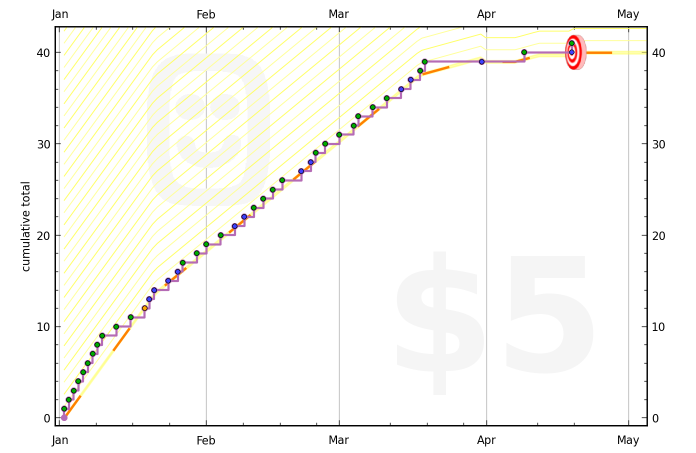
This is a guest post by Michelle Robindell of Ripple Effect Coaching with a prescript by Daniel Reeves of Beeminder.
My first reaction to the idea of gratitude journaling — which I didn’t realize was a thing, until people started beeminding it — was, well, I’ll spare you my snark. Then I tried to articulate my knee-jerkery and came up with this: It seems to have a protesteth-too-much vibe. I mean, what’s not to be grateful for? Everything is amazing! Even the poorest of us live in historically unfathomable luxury. Hot showers, personal carriages to transport you anywhere in the world, practically swimming in food. Mattresses and fluffy pillows and heat and air conditioning. Seriously mind-boggling luxury; I’m not being at all sarcastic. Almost all of the work it takes to keep yourself fed, clothed, sheltered, clean, etc — the chores of daily life — most of it is just done for you, even if you’re poor. You don’t hand-wash your clothes or fetch water or have to build anything or make soap or split firewood or whatever other things would take up most waking hours before we found ourselves in this opulent world. Fine, most people do the equivalent of that for 40 hours/week, working to be able to afford all this luxury, but, really, you could get pretty much every luxury I just mentioned for probably 10 hours/week of work, at minimum wage. [1] It wouldn’t be quite as nice, but, well, that’s another thing: All the things we think of as separating rich from poor in the first world is truly quibbling. Threadcount of your sheets? How fast your car could go if it were legal to go that fast? Whether you’re a little cramped or not in the seat in the motherfrakking airplane that’s flying you thousands of miles in a matter of hours? How conveniently located your magically lighted and heated home is?
I sure am grumpy about how wonderful everything is! Actually, what’s interesting is that there’s simultaneously an infinite list of things to be happy about and an infinite list of things to be unhappy about. Like crime and cancer and computers crashing. So I guess I now understand gratitude journals: it’s a trick to keep some of your attention on the first list. I’m grateful that I don’t have that problem.
But then I thought I should try it out. Here’s how it’s going so far:

(Click the graph to see my entries.) I think I’m a convert. It’s fun at the very least. But let me turn it over to Michelle Robindell for some deeper insight (and actual research!) on gratitude journaling…
Gratitude Journaling, by Michelle Robindell
A few years ago, I participated in a weekly “Happiness Circle” series led by another co-active coach, Sarah Dakin. There, we talked about, learned about, and practiced happiness. The biggest and most helpful habit I took away from that experience was the practice of writing a daily Gratitude Journal. It’s very simple: each day, write down three things you’re grateful for.
It is well-documented that having a daily practice of gratitude journaling can improve our happiness.
According to Brené Brown, research professor at the University of Houston, gratitude and joyfulness are inextricably linked: “Every research participant who spoke about the ability to stay open to joy also talked about the importance of practicing gratitude.” [2] She goes on to say that having an “attitude of gratitude” or simply “feeling grateful” weren’t enough — participants spoke of tangible gratitude practices such as gratitude journals, gratitude jars, and family gratitude rituals.
A 2003 experiment found that those who kept gratitude journals on a weekly basis exercised more regularly, reported fewer physical symptoms, felt better about their lives as a whole, and were more optimistic about the upcoming week compared to those who recorded hassles or neutral life events [3]. In a more recent study [4], Emmons and Mishra discovered that grateful people:
- report higher levels of positive emotions, life satisfaction, vitality, optimism and lower levels of depression and stress;
- have the capacity to be empathic and to take the perspective of others;
- are more likely to acknowledge a belief in the interconnectedness of all life and a commitment to and responsibility to others;
- place less importance on material goods; they are less likely to judge their own and others success in terms of possessions accumulated; they are less envious of others; and are more likely to share their possessions
For about six months as I participated in the Happiness Circle, I dutifully wrote in my gratitude journal. I really did find that it made a big difference to my happiness. I was more appreciative of my family members, the roof over my head, the food in my fridge, and even the little things like fall leaves crunching under my feet. I even appreciated things I would normally complain about: the rain (for feeding our rainforests), the alarm clock (that made sure I got up on time every morning), my dog barking (to let us know we might be under squirrel attack). And the days I most needed it (you know, those Mondays where everything seems to go wrong) were the days my gratitude journal made the biggest difference.
But then I got out of the habit. We put our house on the market and everything had to be put away tidily. My journal, normally sitting on my bedside table where I couldn’t forget to write in it, was tucked away in a drawer.
I don’t know about you, but when I forget to do something, even for one day, it completely throws me off. The next day, I’m not sure whether I should write two entries, or if I should just skip that day and go on to the next one. I freeze, and I don’t make a decision at all. So my gratitude journal sat idle for several months. Several stressful months (while our house sat on the market, and we had to keep it spotless). If ever there was a time to improve my happiness, this was it.
Coincidentally, one of my coaching clients introduced me to Beeminder. I started to use it to track my sugar intake — I’m aiming for 1 serving every second day — and it worked like a charm!
“Why not use Beeminder to track my gratitude?”
After we (finally) sold our house and moved, I decided to start writing in my gratitude journal again. But I couldn’t find it! It must still be packed in a box. It occurred to me — why not use Beeminder to track my gratitude? Now I get an email on a daily basis, in the evening as I’m settling in. I just need to do a quick reply and I’ve captured my three items of gratitude. If I add a fourth one every once in a while, it means I have some “buffer” and if I forget to do it one evening, it’s okay — I can skip that day. It means I can do it whether I’m at home on my computer or out and on my blackberry. I highly recommend it!
Need more detailed instructions? Let’s return to Robert Emmons, the leading scientific expert on gratitude, for his research-based tips:
- Don’t just go through the motions. Research by psychologist Sonja Lyubomirsky and others suggests that journaling is more effective if you first make the conscious decision to become happier and more grateful. “Motivation to become happier plays a role in the efficacy of journaling,” says Emmons.
- Go for depth over breadth. Elaborating in detail about a particular thing for which you’re grateful carries more benefits than a superficial list of many things.
- Get personal. Focusing on people to whom you are grateful has more of an impact than focusing on things for which you are grateful.
- Try subtraction, not just addition. One effective way of stimulating gratitude is to reflect on what your life would be like without certain blessings, rather than just tallying up all those good things.
- Savor surprises. Try to record events that were unexpected or surprising, as these tend to elicit stronger levels of gratitude.
- Don’t overdo it. Writing occasionally (once or twice per week) is more beneficial than daily journaling. In fact, one study by Lyubomirsky and her colleagues found that people who wrote in their gratitude journals once a week for six weeks reported boosts in happiness afterward; people who wrote three times per week didn’t. “We adapt to positive events quickly, especially if we constantly focus on them,” says Emmons. “It seems counterintuitive, but it is how the mind works.”
Here’s my own graph, which you can click on to see my actual entries:

Image source for the skywritten heart: all over the internets
Footnotes
[1] I promise there are no political undertones here, just marveling at how — relatively speaking — awesome everything is.
[2] Emmons, R. A. & McCullough, M. E. (2003). Counting blessings versus burdens: An experimental investigation of gratitude and subjective well-being in daily life. Journal of Personality and Social Psychology, 84, 377-389.
[3] Emmons, R. A., & Mishra, A. (in press). “Why gratitude enhances well-being: What we know, what we need to know.” In Sheldon, K., Kashdan, T., & Steger, M.F. (Eds.) Designing the future of positive psychology: Taking stock and moving forward. New York: Oxford University Press.
[4] Brown, Brené. Daring Greatly: How the Courage to Be Vulnerable Transforms the Way We Live, Love, Parent, and Lead. New York, NY: Gotham, 2012. 123. Print.